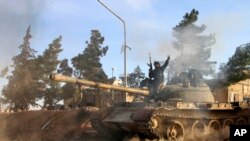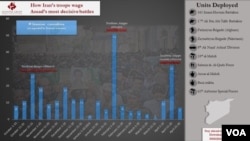Keeping Syrian President Bashar al-Assad in power has come with a deadly price tag for Iran, which has lost more troops in the war-torn country in the past six months than in the previous two years.
More than 280 Iranian troops have been killed in Syria since September of last year, according to an analysis by the Levantine Group of casualties reported by Iranian media.
The willingness to sustain such a heavy rate of losses is evidence of Tehran's commitment to the Assad regime, but also seems to show that Iran is counting on its forces to stand in for what the Levantine Group describes as a "decomposing" regime army.
"Iranian operatives are not mere military advisers spread out along regime lines," said geopolitical and security analyst Michael Horowitz.
"Iranian troops are in fact concentrated around Aleppo, where they fought all of Assad's battles," he said. "They serve as the tip of the spear, rather than advisers."
In fact, two of the deadliest months for Iranian troops can be tied directly to fighting in and around Aleppo.
Tehran's troops suffered 50 casualties during its most recent counteroffensive last month in southern Aleppo, according to the Levantine Group analysis.
Only February saw more fatalities, when 64 troops were killed — 51 of them during a 10-day span that coincided with an offensive in northern Aleppo.
U.S. confirmation
U.S. officials have been watching Iran's military maneuvers in Syria closely and say it is clear that the heavy fighting has taken a toll — especially on units belonging to its Revolutionary Guard Corps, such as the Quds Force.
"Iran continues to withdraw some of its more elite forces from Syria and replace them with troops of lower caliber," a U.S. intelligence official told VOA.
That process, which began last month, came as Iran stepped up its efforts following a decision by Russia in March to withdraw some forces, including some of its air power, from Syria. And it may be exposing a key weakness for Iran's forces.
"Without Russian air support, it seems that their effectiveness is marginal," the Levantine Group's Horowitz said.
"After the Russian withdrawal, more than 40 Iranian troops were killed as they launched a counteroffensive in southern Aleppo, yet weren't able to reverse the opposition gains in the area," he said.
In contrast, with Russian air support during the Iranian-led February offensive in northern Aleppo, pro-regime forces were able to cut the main supply line for opposition forces.
The analysis also noted lower Iranian casualties during the Russian-led offensive to retake the city of Palmyra from the Islamic State terror group, suggesting either that Iran's forces benefited from the use of Russia's helicopter gunships or that they played a lesser role in the offensive.












